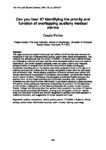Can you hear it? Identifying the priority and function of overlapping auditory medical alarms
| dc.contributor.author | Parker, Cassie | |
| dc.date.accessioned | 2021-07-08T19:36:22Z | |
| dc.date.available | 2021-07-08T19:36:22Z | |
| dc.date.issued | 2021 | |
| dc.identifier.citation |
Parker, C. (2021) ‘Can you hear it? Identifying the priority and function of overlapping auditory medical alarms’, The Plymouth Student Scientist, pp. 639-657. | en_US |
| dc.identifier.uri | http://hdl.handle.net/10026.1/17317 | |
| dc.description.abstract |
This paper presents an experimental study that exhibits the differences seen between the recognition of high and moderate priority auditory alarms when played simultaneously. Past research has demonstrated that the current IEC-60601-1-8 alarms used in clinical settings are challenging to identify and learn, and that newly developed auditory icons are easier to discriminate. The current research compares these two types of alarms and measures participant ability to recognise both the function and priority of single sounding and combination sounding alarms. Participants were either assigned to listen to IEC alarms or auditory icons and had to determine the function and priority of each alarm for both single and combination trials. Results display a significant difference between alarm priority and function identification in participants in the auditory icon condition, compared with those in the IEC alarms condition. Participants showed greater overall identification accuracy with auditory icons, for both single sounding and combination sounding trials. A significant difference was also found in priority identification in participants exposed to single sounding IEC alarms, where participants were better at identifying the priority of the IEC alarms but not the function. Explanations for this result are discussed with concern to alarm efficacy. Overall, findings from this study show that auditory icons outperform the current IEC alarms on both function and priority identification, proving to be the superior of the two. Results imply the importance of priority and function recognition in auditory icons when placed in a medical environment, and suggestions for further research are made. | en_US |
| dc.language.iso | en | en_US |
| dc.publisher | University of Plymouth | en_US |
| dc.rights | Attribution 3.0 United States | * |
| dc.rights.uri | http://creativecommons.org/licenses/by/3.0/us/ | * |
| dc.subject | auditory comparisons | en_US |
| dc.subject | priority auditory alarms | en_US |
| dc.subject | IEC-60601-1-8 | en_US |
| dc.subject | clinical settings | en_US |
| dc.subject | auditor icons | en_US |
| dc.subject | identification accuracy | en_US |
| dc.subject | alarm efficacy | en_US |
| dc.subject | hearing | en_US |
| dc.subject | psychology | en_US |
| dc.title | Can you hear it? Identifying the priority and function of overlapping auditory medical alarms | en_US |
| dc.type | Article | en_US |
| plymouth.issue | 1 | |
| plymouth.volume | 14 | |
| plymouth.journal | The Plymouth Student Scientist |



